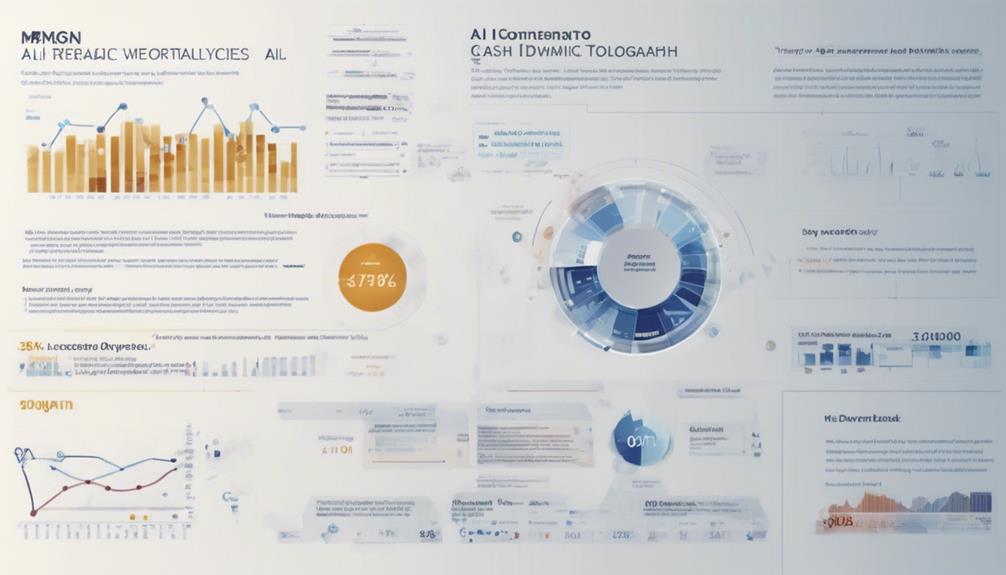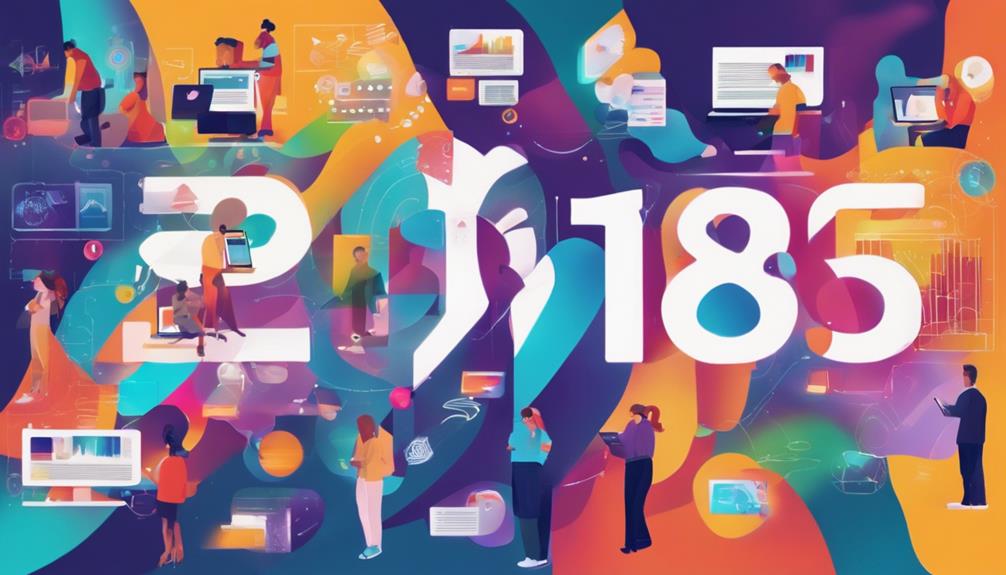JPMorgan's Cash Flow Intelligence AI tool is revolutionizing cash flow management for corporate clients by greatly enhancing operational efficiency. Launched to reduce manual workloads, it employs advanced algorithms to analyze and categorize cash flows effectively. This innovative tool facilitates accurate forecasting, enabling improved financial planning and strategic resource allocation. Approximately 2,500 clients have adopted it, benefiting from increased visibility into their financial positions. As the financial landscape becomes more competitive, the integration of such AI technologies is essential for informed decision-making and operational improvement. There's much more to explore about its features and implications for the industry.
Key Takeaways
- JPMorgan's Cash Flow Intelligence AI tool aims to reduce manual labor and enhance operational efficiency for corporate clients.
- The tool has been adopted by approximately 2,500 clients, streamlining cash flow processes for better resource allocation.
- Its intuitive interface analyzes cash flows, creating accurate forecasts and improving financial planning for users.
- Advanced algorithms enhance data analysis, providing greater visibility into financial positions for informed decision-making.
AI Implementation at JPMorgan

In its pursuit of generating $1.5 billion in business value through artificial intelligence in 2023, JPMorgan has successfully launched a free Cash Flow Intelligence AI tool that markedly reduces manual labor for corporate clients.
This innovative tool has garnered significant traction, with approximately 2,500 clients adopting it since its introduction.
The implementation of this AI solution is indicative of JPMorgan's commitment to enhancing operational efficiency and optimizing financial management for its users.
By minimizing manual input, the tool effectively streamlines cash flow processes, thereby allowing clients to allocate resources more strategically.
As the landscape of corporate finance evolves, JPMorgan's AI initiative positions the firm at the forefront of technological advancements in the banking sector, paving the way for future growth and innovation.
Tool Features and Benefits

How does the Cash Flow Intelligence AI tool enhance corporate cash flow management?
This intuitive interface not only analyzes and categorizes cash flows but also assists clients in creating accurate forecasts, greatly improving the overall financial planning process.
The tool's advanced algorithms streamline the analysis of complex cash flow data, allowing users to identify trends and potential issues swiftly.
Clients benefit from enhanced visibility into their financial positions, enabling informed decision-making.
Furthermore, the collaborative nature of human-machine interaction guarantees that critical judgments remain with experienced professionals, while the AI handles data-heavy tasks.
Ultimately, this tool reduces manual workload considerably, making cash flow management more efficient and reliable, positioning clients for sustained financial success.
Industry Comparisons

Numerous banks are increasingly developing AI tools for cash flow management, reflecting a competitive landscape in the financial services sector.
For instance, Bank of America has launched a free AI CashPro forecasting tool aimed at enhancing clients' cash flow predictions.
Similarly, RBC offers the NOMI tool, which assists users in tracking their cash flows effectively.
These initiatives indicate a growing trend among financial institutions to leverage AI technology to improve cash flow management solutions.
As competition intensifies, banks are working to differentiate their offerings, ensuring that clients receive innovative, efficient tools.
This shift towards AI integration not only enhances operational efficiency but also sets the stage for future advancements in financial services across the industry.
CEO Insights and Predictions

Jamie Dimon emphasizes that advancements in AI are poised to reshape business operations and considerably alter workforce dynamics. He predicts that future work weeks may average just 3.5 days, reflecting a shift driven by AI integration.
Dimon underscores the importance of adapting to these technological changes, which promise to enhance efficiency and productivity across various sectors. He envisions a workforce that collaborates seamlessly with AI tools, leveraging human intelligence alongside machine capabilities.
This transformation will not only streamline processes but also redefine roles within organizations. As businesses embrace AI, Dimon anticipates a continuous evolution in workplace dynamics, urging leaders to prepare for a future where technology plays an integral role in operational success.
Related Business Trends

The integration of AI tools is markedly influencing contemporary business trends, reshaping strategies across various sectors, including startup fundraising and crisis management.
As entrepreneurs increasingly leverage AI for streamlined operational efficiencies, the landscape for fundraising is evolving, allowing startups to attract investments more effectively.
Moreover, the shift in crisis management practices, exemplified by public figures like Taylor Swift utilizing data-driven approaches, showcases the necessity for adaptable strategies in turbulent times.
Additionally, there's a growing interest in pursuing profitable small business ideas without traditional qualifications, reflecting a democratization of entrepreneurship.
Mark Zuckerberg's advocacy for open-source AI further emphasizes the movement towards collaborative innovation, enhancing accessibility and fostering a competitive edge in the market.
Frequently Asked Questions
How Secure Is the Data Processed by Jpmorgan's AI Tool?
The security of data processed by JPMorgan's AI tool is paramount, involving robust encryption, compliance with industry regulations, and continuous monitoring to safeguard sensitive financial information against unauthorized access and potential breaches.
What Companies Are Eligible to Use the Cash Flow Intelligence AI Tool?
Eligible companies for the Cash Flow Intelligence AI tool include corporations seeking enhanced financial insights, such as a mid-sized manufacturer aiming to optimize cash flow forecasting. The tool is designed specifically for corporate clients within various industries.
Are There Any Costs Associated With the AI Tool After Its Free Phase?
Currently, the AI tool is offered free of charge to corporate clients. However, future plans may involve introducing costs based on the tool's success and user adoption, potentially shifting from a free to a paid model.
How Often Is the AI Tool Updated With New Features?
The frequency of updates for the AI tool is not publicly specified, but ongoing enhancements are anticipated to guarantee peak performance and user satisfaction, reflecting the dynamic nature of technology and client needs in financial services.
Can the AI Tool Integrate With Existing Financial Software Systems?
The AI tool is designed for seamless integration with existing financial software systems, enhancing user experience while ensuring compatibility. This interoperability allows clients to leverage their current infrastructure alongside advanced cash flow analysis capabilities.
Conclusion
To sum up, JPMorgan's innovative Cash Flow Intelligence AI tool exemplifies a significant leap in financial technology, akin to a lighthouse guiding vessels through turbulent waters. JPMorgan’s Cash Flow Intelligence AI tool not only streamlines financial processes but also showcases the power of artificial intelligence in revolutionizing the banking and finance industry. With its ability to analyze vast amounts of data and generate real-time insights, this tool represents the cutting edge of financial technology. Furthermore, it demonstrates nvidia’s dominant role in AI, as their technology powers the AI capabilities behind the Cash Flow Intelligence tool, cementing their position as a leader in the field of artificial intelligence.
By substantially reducing manual workloads and enhancing forecasting capabilities, this advancement not only positions JPMorgan at the forefront of the industry but also sets a benchmark for competitors.
As the banking sector increasingly embraces AI, the potential for transformative efficiency and strategic collaboration continues to expand, shaping the future of finance.









